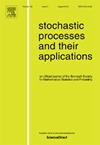The phase transition of the voter model on evolving scale-free networks
IF 1.2
2区 数学
Q3 STATISTICS & PROBABILITY
引用次数: 0
Abstract
The voter model on a social network can explain consensus formation, where real networks feature a heterogeneous degree distribution and also change in time. We study the voter model in an environment with both features: a rank one scale-free network evolving in time by each vertex updating its edge neighbourhood at rate .
When the dynamic giant has no effect up to a polylogarithmic correction, but for more slowly changing graphs consensus takes longer without a dynamic giant. This continues until , where this factor becomes .
演化无标度网络上选民模型的相变
社会网络上的选民模型可以解释共识的形成,而现实网络具有异质度分布和随时间变化的特点。我们在一个具有两个特征的环境中研究选民模型:一个由每个顶点以k的速率更新其边缘邻域的秩一无标度网络。当κ > 1时,动态巨量对多对数校正没有影响,但对于变化较慢的图,如果没有动态巨量,共识需要1κ更长时间。这种情况一直持续到κ≪1N,此时因子1κ变为NlogN。
本文章由计算机程序翻译,如有差异,请以英文原文为准。
求助全文
约1分钟内获得全文
求助全文
来源期刊

Stochastic Processes and their Applications
数学-统计学与概率论
CiteScore
2.90
自引率
7.10%
发文量
180
审稿时长
23.6 weeks
期刊介绍:
Stochastic Processes and their Applications publishes papers on the theory and applications of stochastic processes. It is concerned with concepts and techniques, and is oriented towards a broad spectrum of mathematical, scientific and engineering interests.
Characterization, structural properties, inference and control of stochastic processes are covered. The journal is exacting and scholarly in its standards. Every effort is made to promote innovation, vitality, and communication between disciplines. All papers are refereed.
 求助内容:
求助内容: 应助结果提醒方式:
应助结果提醒方式:


